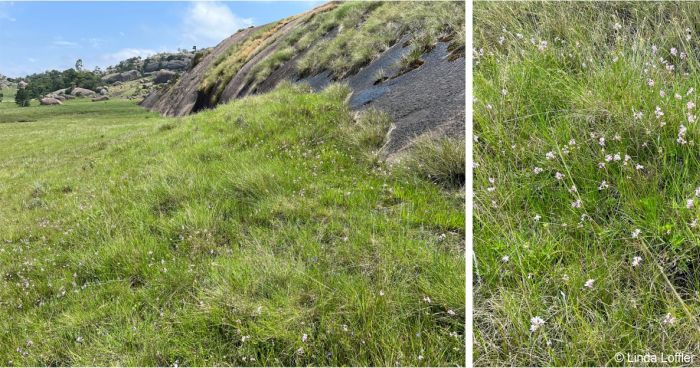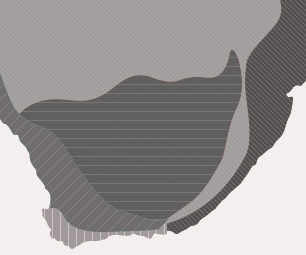Tulbaghia coddii
Tulbaghia coddii Vosa & R.B.Burb.
Family: Amaryllidaceae
Common names: poet’s garlic, Codd’s wild garlic (Eng.)
Introduction
Tulbaghia coddii is a rare and delicate bulbous geophyte with garlic-scented bright green leaves and beautiful sweetly fragrant flowers in spring and early summer.

Description
Description
Tulbaghia coddii is a delicate, evergreen, clump forming, bulbous geophyte that grows 150–250 mm tall. The rootstock is a small fleshy bulb with a thick rhizome, and roots that make up the largest portion of the rootstock as the bulb is small. The bulb produces 6 to 8 leaves that are thin and filiform (thread-like) and grow up to 250 mm long. The leaves are bright green, erect and firm, with a garlic smell when bruised or broken.

It produces pale pink to white, sweetly scented flowers in spring to summer (September to February), in an umbel of up to 5 flowers at the tip of a flower stalk that is 150–300 mm long, emerging from the bulb, and always taller than the leaves. The flowers are connected to the flower stalk by short, thin, brown pedicels that are purple at the tips, where they meet the umbel of flowers. The flower is shaped somewhat like a trumpet, the perianth tube is cylindrical at the base with distinct darker lines, the tube is about two thirds of the flower length, and the tepals are a third of the flower length. The tube is pink and tepals are pinkish white. The perianth segments are pink or white contrasting with the yellow-green corona that is shaped like a crown. The flower petals start folded and they gradually open up, showing 6 tepals that have a slightly in-rolled margin, before completely opening up. The plant produces black seeds in green capsules that mature to cream-white capsules that open and expose the seeds when they have ripened.

Conservation Status
Status
Tulbaghia coddii is assessed as Rare by the Red List of South African plants because it occurs over a small range. This species was considered Vulnerable in the 2009 assessment. In the past, it lost a significant area of its natural habitat to commercial forestry plantations, but currently, more than 80% of the population that remains is in grassland habitats that are well protected and the wild population is no longer declining.

Distribution and habitat
Distribution description
According to the SANBI Red List, Tulbaghia coddii is a South African endemic that occurs in Mpumalanga Province, however the plant has been recorded and confirmed by Linda Loffler to be growing in Hhohho, Eswatini, an area adjacent to Mpumalanga Province where it is also naturally occurring. Its distribution range in South Africa is between Mount Sheba, Graskop and Mariepskop where it grows in abundance on damp grassland, on the edges of wet and boggy seasonal ponds, in shallow soil over sheet rocks, and in open grassland with clay soil.

Derivation of name and historical aspects
History
The genus Tulbaghia is named after Ryk Tulbagh who was a Governor of the Cape of Good Hope in 1757 to 1771. Tulbaghia is one of more than 200 species he sent to Linnaeus, and this genus was described from the material that he had sent in 1769. This species is named after Dr. L.E.W. Codd, a South African plant taxonomist who was the Director of the Botanical Research Institute in Pretoria from 1963 to 1973.
Tulbaghia coddii has previously suffered habitat loss due to its natural habitat being used for commercial plantation of timber, the threat has however declined as the timber plantations are no longer expanding.
Tulbaghia is a small plant genus with about 30 species, which are all indigenous to the southern African region, it falls under Allioideae, a subfamily in the Amaryllidaceae family. The Allioideae was previously treated as a separate family Alliaceae. In 1998, the Angiosperm Phylogeny Group Journal had recommended that Alliaceae (onion family), Agapanthus then in the Alliaceae and Amaryllis be combined under the same family. It was only on the 2023 Angiosperm Phylogeny Group Journal where the merge to Amaryllidaceae came to effect and Alliaceae family was reduced to a subfamily known as Allioideae. Agapanthus has since been moved to its own family Agapanthaceae.
In the past subfamily Allioideae had 3 indigenous genera, which included monospecific Prototulbaghia siebertii which is now classified as Tulbaghia siebertii. Currently the Allioideae consists of 2 indigenous genera, which include all the southern African Tulbaghia species and the monotypic species Allium synnottii, which is believed to have been introduced to the region by early European colonists. This subfamily is characterized by the garlic odour caused by the secretion of the unique chemical (allyl sulfide) on the leaves of these species, and solid styles.
Most Tulbaghia species are confined to the Southern Hemisphere and the majority of species are endemic to southern African countries. In South Africa this genus is found in all provinces but is mainly distributed in Eastern Cape, Gauteng, KwaZulu Natal, Limpopo and Mpumalanga. Eastern Cape has the highest frequency of Tulbaghia occurrence when compared to the other provinces. Tulbaghia generally occurs in the summer-rainfall region, on dry or damp rocky grasslands while some are found on marshy stream banks. Tulbaghia capensis and Tulbaghia alliacea are adapted to a winter-rainfall climate.

Ecology
Ecology
Tulbaghia coddii is one of the Tulbaghia species that is adapted to wet and boggy conditions, and these species possess unique seed coats that feature flat cells surrounded by ribbon-like sutures that prevents seeds from sinking, and allows the seeds to float in water for extended periods, until the wind or the movement of water itself may carry them to the edge of the streams or seasonal ponds where conditions are favourable for the seeds to germinate.
The pollination biology of Tulbaghia coddii has yet to be studied. Generally Tulbaghia flowers attract both bees and butterflies during daytime, and some species produce their floral fragrance at night which suggests that they attract moths as pollinators.

Uses
Use
There are no recorded medicinal or cultural uses for Tulbaghia coddii, but it is a charming species that can be used as an ornamental in the garden and is ideally suited to marshy grassy areas in full sun and is also suitable for mixed beds and containers.
Tulbaghia species are known to be extensively used for food and for traditional medicinal purposes in southern Africa. Tulbaghia violacea remains the best known and most used species.
Growing Tulbaghia coddii
Grow
Tulbaghia coddii is an easy plant to grow. Grow this plant species in moist, well-drained soil enriched with compost. It grows well in full sun and partial shade where it can be grouped together or mass planted as a groundcover. Like most Tulbaghia species, Tulbaghia coddii is resistant to many pests and diseases and this is due to the pungent smell from the leaves, but slugs and snails seem to be able to resist the strong scent and can damage the leaves.
Tulbaghia coddii can be propagated sexually and asexually.
The seeds can be collected once the seed capsule opens, which is an indication that the seeds are ripe. Seeds must be sown in summer, in a deep tray to allow the roots to develop freely, in a well-drained medium and they can be kept and maintained in a tray for a year before they are transplanted to a larger pot or bag, this is done so that the small bulb is not disturbed because it can break easily. After the first year they can then be transplanted and plants may produce their first flowers in their second year.
Division is another method of propagation that can be used, select larger clumps of this species, carefully divide them into individual plants and ensure the bulb is not damaged as this could delay flowering. Division is best done in spring when growth commences. The divided individual plants can be transplanted into bags or planted directly in the ground.
References
- Aremu A.O. & Van Staden, J. 2013. The genus Tulbaghia (Alliaceae) – a review of its ethnobotany, pharmacology, phytochemistry and conservation needs. Journal of Ethnopharmacology 149(2): 387–400.
- Attwood, M. 2024. Observation of Tulbaghia coddii, Ehlanzeni, Mpumalanga. iNaturalist. Online. https://www.inaturalist.org/observations/243786465.
- Attwood, S. 2024. Observation of Tulbaghia coddii, Blyde River Canyon Reserve, Mpumalanga. iNaturalist. Online. https://www.inaturalist.org/observations/243854118.
- Brent, R. 1960. Specimen of Tulbaghia coddii, National Herbarium, Pretoria. Available via JSTOR: https://plants.jstor.org/stable/pdf/10.5555/al.ap.specimen.pre0476309-0.
- Codd, L.E.W. 1951. Type specimen of Tulbaghia coddii, National Herbarium, Pretoria. Available via JSTOR: https://plants.jstor.org/stable/pdf/10.5555/al.ap.specimen.pre0592645-0.
- Germishuizen, G. & Fabian, A. 1997. Wild flowers of northern South Africa. Fernwood Press, Vlaeberg, Cape Town.
- iNaturalist. Amaryllis, Onions and Allies (Family Amaryllidaceae). https://www.inaturalist.org/taxa/55849-amaryllidaceae. Accessed on 21/02/2025.t
- iNaturalist. Family Alliaceae. https://www.inaturalist.org/taxa/47358-alliaceae. Accessed on 03/03/2025.
- iNaturalist. Wild Garlics (Genus Tulbaghia. https://www.inaturalist.org/taxa/119384–tulbaghia. Accessed on 03/03/2025.
- Jäger, A.K. & Stafford, G.I. 2012. Quality assessment of Tulbaghia rhizomes. South African Journal of Botany 82:92–98.
- Loffler, L. 2024. Observation of Tulbaghia coddii, Hhohho Region, Eswatini. iNaturalist. Online. https://www.inaturalist.org/observations/246459782.
- Lyantagaye, S. L., 2011. Ethnopharmacological and phytochemical review of Allium species (Sweet Garlic) and Tulbaghia species (Wild Garlic) from southern Africa. Tanzania Journal of Science 37: 58–72.
- Meerow, A. 2023. Classification and phylogeny of Amaryllidaceae, the modern synthesis and the road ahead: a review. Boletín de la Sociedad Argentina de Botánica 58(3).
- Pacific Bulb Society. Tulbaghia. https://www.pacificbulbsociety.org/pbswiki/index.php/tulbaghia. Accessed on 19/02/2025.
- Pooley, E. 1998. A field guide to wild flowers of Kwazulu-Natal and the eastern region. Natal Flora Publications Trust, Durban.
- Shields Gardens. The Amaryllis Family: Amaryllidaceae. https://www.shieldsgardens.com/amaryllids/amaryllis.html. Accessed on 19/02/2025.
- Stafford, G.I., et al. 2016. The first phylogenetic hypothesis for the southern African endemic genus Tulbaghia (Amaryllidaceae, Allioideae) based on plastid and nuclear DNA sequences. Botanical Journal of the Linnean Society 181: 156–170.
- Styger, G., Aboyade, O. M., Gibson, D., Hughes, G. 2016. Tulbaghia – a southern African phytomedicine. The Journal of Alternative and Complementary Medicine 22: 255-261.
- Von Staden, L. 2011. Tulbaghia coddii Vosa & Burb. National Assessment: Red List of South African Plants. Online. https://redlist.sanbi.org/species.php?species=483-11.
- Vosa, C. G. 2003. On the ecological significance of seed-coat patterns in the genus Tulbaghia (Alliaceae). Caryologia 56(2): 139–141.
- Vosa, C.G. 2000. A revised cytotaxonomy of the genus Tulbaghia, (Alliaceae). Caryologia 53: 2 (83–112). https://examine.com/supplements/tulbaghia-violacea/
- Wikipedia. Tulbaghia coddii. https://af.wikipedia.org/wiki/tulbaghia_coddii. Accessed on 03/03/2025
Credits
Ziphezinhle Madonsela
Lowveld National Botanical Garden
May 2025
Acknowledgements: The author thanks Simon Attwood and Maru Attwood for providing images for this article, and Linda Loffler for confirming the existence of a population in Hhohho, eSwatini and providing images of it too.
Plant Attributes:
Plant Type: Bulb
SA Distribution: Mpumalanga
Soil type: Clay, Loam
Flowering season: Spring, Early Summer, Late Summer
PH: Acid
Flower colour: White, Pink, Yellow, Mauve/Lilac
Aspect: Full Sun, Morning Sun (Semi Shade), Afternoon Sun (Semi Shade)
Gardening skill: Easy
Special Features:
Horticultural zones









Rate this article
Article well written and informative
Rate this plant
Is this an interesting plant?
Login to add your Comment
Back to topNot registered yet? Click here to register.